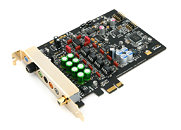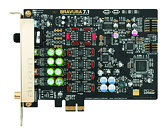Monday, January 18th 2010

Auzentech Announces the Auzen X-Fi Bravura 7.1 PCI-Express Sound Card
Auzentech, Inc today announced the immediate release of the Auzen X-Fi Bravura 7.1 sound card, a full-height, custom designed PCI Express sound card built around the Creative PCI Express audio processor. The Auzen X-Fi Bravura 7.1 promises "breathtaking" audio for music and movies with DTS Neo:PC & DTS Interactive. And when it's time to unwind with your favorite PC Game, you won't be left behind with EAX 4.0.
Below are the Auzen X-Fi Bravura 7.1 sound card Key Features, Innovations, and some inside information on how Auzentech designed the card for optimal performance with both Digital and Analog audio.Key Features
Auzentech has a history of offering sound cards with innovative technology. The Auzen X-Fi Bravura 7.1 sound card continues that tradition with Input / Output Mode Control so the user can adapt the sound card to the environment, Independent Headphone Output Circuitry for professional headphones, and Auzentech's proprietary Pointing Ground Power Supply for audio free from power supply noise.
Digital and Analog
As with all previous Auzentech sound cards, the Auzen X-Fi Bravura 7.1 is designed for optimal audio output, both Digital and Analog. The Creative X-Fi PCI Express Core Interface audio processor is located on the back of the circuit board, while the analog circuitry is on the front. This allows for greater signal differentiation and better-performing analog circuit design.
The Auzen X-Fi Bravura 7.1, a full-height, custom designed PCI Express sound card for audiophiles and HomeTheater PC enthusiasts that includes impressive gaming capabilities, is available now from Auzentech and participating retailers. For more information, visit: Auzentech.
Below are the Auzen X-Fi Bravura 7.1 sound card Key Features, Innovations, and some inside information on how Auzentech designed the card for optimal performance with both Digital and Analog audio.Key Features
- Creative X-Fi native PCI Express audio processor
- Supports 7.1 channel playback up to 24-bit/96kHz for speaker outputs
- Supports stereo playback up to 24-bit/192kHz with 120dB DAC for Headphone output
- All output OPAMPs (x5) are replaceable by the end-user
- Exclusive Hi-Fi headphone amplifier supports professional headphones with 1/4" phone jack
- Stereo/Balanced mode microphone pre-amplifier supports professional microphones
- Premium quality audio parts
- I/O Mode Control, Pointing Ground Design, X-Balance Power Generation System (described below)
- Optical/Coaxial combo connector for S/PDIF output
- Intel HD Audio 10-1 pin front panel connector
Auzentech has a history of offering sound cards with innovative technology. The Auzen X-Fi Bravura 7.1 sound card continues that tradition with Input / Output Mode Control so the user can adapt the sound card to the environment, Independent Headphone Output Circuitry for professional headphones, and Auzentech's proprietary Pointing Ground Power Supply for audio free from power supply noise.
Digital and Analog
As with all previous Auzentech sound cards, the Auzen X-Fi Bravura 7.1 is designed for optimal audio output, both Digital and Analog. The Creative X-Fi PCI Express Core Interface audio processor is located on the back of the circuit board, while the analog circuitry is on the front. This allows for greater signal differentiation and better-performing analog circuit design.
The Auzen X-Fi Bravura 7.1, a full-height, custom designed PCI Express sound card for audiophiles and HomeTheater PC enthusiasts that includes impressive gaming capabilities, is available now from Auzentech and participating retailers. For more information, visit: Auzentech.


44 Comments on Auzentech Announces the Auzen X-Fi Bravura 7.1 PCI-Express Sound Card
Edit: Thats not a dumb question Im asking. Im really looking for a better sound card but they are all greek to me.
Although, it wouldn't surprise me if it was some kind of "number of license" deals, and Auzen are trying to get out of it by cranking out as many X-Fi supporting series as possible.Take a look at the guide linked in my sig - nearly all dedicated cards are better than onboard. The lower-end cards might have nearly comparable quality, but still generally far surpass even the best onboard solutions.meh . . . EAX has it's highlights, and it's quality changes from one game to the next. It's not so much the library itself, as much as it is how the game developers impliment it . . . and, sadly, most game developers just slap EAX capabilities into a game without any further tweaking or configuring to properly match the game world . . . and it sounds like crap. Titles, though, where it's done well - it really adds immensly to the atmosphere.
Now, for general entertainment purposes, yeah, the EAX effects aren't worth it. The can make poor quality speakers sound a little better, but not that much.Don't understand why not - Creative's APU are simply the fastest on the market . . . as well, the CA20K2 is a native PCI-E APU, whereas all other non-XFi PCI-E cards must use a translator chip, which adds to audio output latency. Depending on system hardware, OS, SYS clock speeds, etc. too much latency can very quickly translate into clipping, crackling, popping, or other audio detritous as the output breaks down due to over-buffering. Also of note, the number of software voices the APU is capable of is staggering compared to other manufacturer's DSPs, and have a direct impact on numerous "effects" that are applied to the output stream . . . everything from speaker virtualization, to ambient occlusion, environmental filtering, reverbration, etc. Suffice it to say, but the X-Fi APUs still own the crown in these regards.
Now, if we were talking about audio output quality, I can see that arguement . . . to an extent. The APU has very little actual impact on output quality, the majority of that actually lies in the DAC . . . which, Creative have been notorious for marginal-quality DACs on their cards . . .
But, this is an Auzen - they use much better quality DACs, as well as other PCB components.
If you want the best of both worlds, both superior audio quality and extreme audio performance, Auzen supporting X-Fi is simply the only way to go.
All though i might pick one of these cards up or one like it to test again once i get my new speakers just to see if the sound is more balenced\open\deeper.
Actually, come to think of it, FEAR had a solid EAX implimentation as well. I had very, very few faults with EAX and FEAR.
Otherwise . . . meh. Too many lazy game developers, IMHO. Audio is constantly overlooked in the gaming realm.Aside from a card's specs, some things to look for in regards to higher audio quality => quality OPAMPs; low quality OPAMPs lead to a lot of channel-bleeding, and can also pick up EMI from surrounding hardware. Multiple and similar DACs; preferablly one per channel, or one per every two channels - and they should be the same, or near similar in output. Some cards have multi-DACs, but there's massive differences betwen them, which can lead to a very unbalanced sounding output with multi-channel setups. Inherent EMI shield; almost a necessity with modern GPUs, WiFi, PSUs, CPUs and such else.
(but if he was referring to the Onboard sound, it is getting a LOT better than it used to be)
More or less, its just a standard. AC97 was the first standard, HD was the next.
Just way to make sure everythings compatible for apps/games/generic driver compatibility.
(notice how vista/7 has generic HD audio drivers? handy, that)
In that case mussels Ive had HD audio capability since 4 years ago when i picked up my current sound card. I just need to put the old PCI 512 back in and playback some MIDI music on it and record with audacity in several formats.
Just to prove that MIDI can sound good when a Hardware MIDI is used vs a Software means.
Auto-sensing jacks
Compatibility with generic HD audio drivers (some sort of generic standard, i beleive)
24 bit audio capability
For comparison, "DVD Audio" is typically speced at 24bit/96kHz for more than 2-channel playback, 24bit/192kHz for 2-channel, with a bitrate of 9.5 Mbit/second; whereas "CD Audio" is typically speced at 16bit/44.1kHz for all channel playback, and a typical bitrate of 1.4 Mbits/second. For further comparison, DolbyHD requires a [/i]minimum[/i] of 24bit/96kHz for all channel output, with a maximum bitrate of 18 Mbit/second - this is actually the standard found on HD-DVDs (including BluRay) . . . if the disc carries a supporting audio track.
For the PC realm, everything "HD" is built to Intel's specs . . . also known as Azalia - in the entertainment/media realm, everything is built along totally different guidelines . . . some use Dolby's standards, some don't. Some companies use their own, etc., etc.
HD Audio really started to come about with the advent of DVD. The media industry realized that they could start offering better audio with all the extra available space, and it started to take off from there . . . mostly because once the user market started demanding more "home theater" hardware was when the manufacturer's really started picking up the ball in their end of the segment. Both have gone hand in hand.
What I find funny, though, is how much everyone is willing to spend on the players, discs and screens that support the HD playback . . . but tend to cheap out when it comes to the speaker setups. :shadedshu
Now, back to the op: The question for me is, this or the Forte?